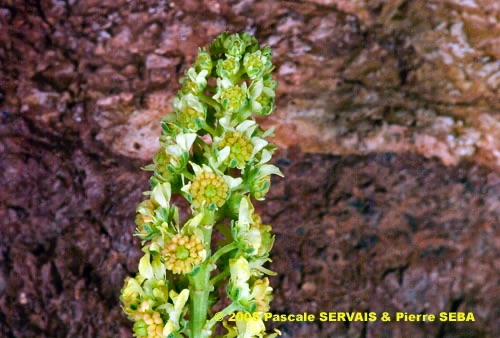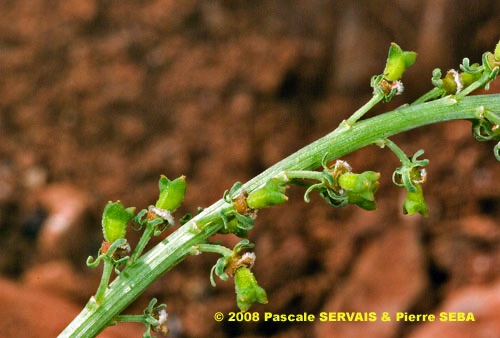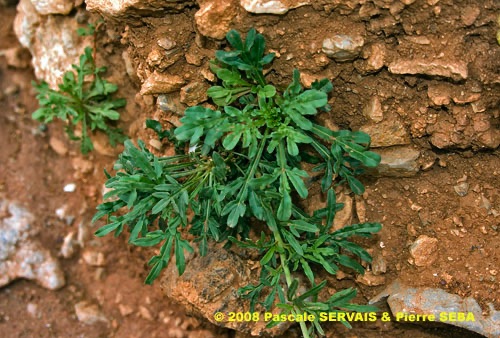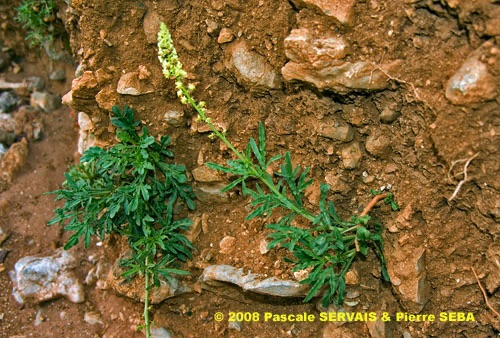
Reseda lutea L.
Fam. : Resedaceae
© Pascale SERVAIS & Pierre SEBA, 2018. Tilo Botanica: Flore de Tilos et du Dodécanèse / Flora of Tilos and of the Dodecanese
English translation by Brenda Bradbury, Howard Bradbury and Stéphane Léonard
Plante herbacée, hermaphrodite, vivace, parfois annuelle ou bisannuelle, à peine ligneuse à la base, à tiges étalées à érigées, glabres, striées, légèrement rugueuses, ramifiées vers le sommet.
Feuilles alternes, divisées pennatipartites à pennatifides, sessiles, étroitement dentées, de 5 à 15 cm de long, glabres, à 1 à 2 paires de lobes, à bords plissés et un peu rugueux.
Fleurs à symétrie radiaire, jaune verdâtre pâle, de 4 à 5 mm de diamètre, réunies en grappes de 8 à 12 cm de long. Corolle à 6 pétales libres, trilobés. Calice à 6 sépales libres. 7 à 25 étamines réunies par leur base. 3 stigmates. Ovaire supère.
Fruits, capsules dressées, oblongues, de 7 à 12 mm de long, à 3 dents courtes.
___________________________
Plant herbaceous, hermaphrodite, perennial, sometimes annual or biennial, scarcely woody at the base. Stems spread out to erect, glabrous, striated, slightly rough, branched towards the top.
Leaves alternate, dissected pinnatipartite to pinnatifid, stalkless, narrowly toothed, from 5 to 15 cm long, glabrous, with 1 to 2 pairs of lobes, with folded and a little rough edges.
Flowers radially symmetrical, pale greenish yellow, from 4 to 5 mm in diameter, joined together in racemes from 8 to 12 cm long. Corolla with 6 free, three-lobed petals. Calyx with 6 free sepals. 7 to 25 stamens joined together by their base. 3 stigmas. Ovary superior.
Fruits, erect, oblong capsules, from 7 to 12 mm long, with 3 short teeth.
Descripteurs / Identifying features
1

2

3

4
Étymologie / Etymology :
Reseda : emprunt du latin reseda, -ae (nom) [ < resedo, -as, -are (verbe)
= calmer, guérir ] = le réséda, nom donné à la plante par Pline,
naturaliste latin mort en 79 apr. J.-C., en référence à ses propriétés
médicinales.
Lutea : emprunt du latin luteus, -a, -um (adj.) [ < lutum, -i (nom)
= la sarriette (plante qui donne une teinture jaune), la couleur jaune ]
= jaune, jaunâtre.
Reseda : borrowed from Latin reseda, -ae (noun)
[ < resedo, -as, -are (verb) = to soothe, to heal ] = mignonette, name
given to the plant by Plinius, Latin naturalist died in 79 AD, referring to
its medicinal properties.
Lutea : borrowed from Latin luteus, -a, -um (adj) [ < lutum, -i (noun)
= savory (plant that gives a yellow dye), yellow colour ] = yellow,
yellowish.
Synonymes / Synonyms :
Reseda benitoi Sennen
Reseda crispa Ten.
Reseda crispa Mill.
Reseda dutoitii Sennen & Mauricio
Reseda fluminensis Simonk.
Reseda gallica Raf.
Reseda ibicensis Pau
Reseda lecoqii Müll.Arg. ex DC.
Reseda macedonica Formánek
Reseda mediterranea L.
Reseda mucronata Tineo
Reseda mucronulata Guss.
Reseda orthostyla K.Koch
Reseda othryana Formánek
Reseda podolica Rehman
Reseda ramosissima Pourr. ex Willd.
Reseda reyeri Porta & Rigo
Reseda tenuifolia Wallr.
Reseda truncata Fisch. & C.A.Mey.
Reseda vinyalsii Sennen
Reseda yannezii Cutanda
Noms vernaculaires / Common names :
Noms français / French names :
Réséda bâtard — Réséda jaune — Réséda sauvage.
Noms grecs / Greek names :
Βρωμούσα η κίτρινος — Ρεζεδά η κίτρινη — Ώχρα.
Noms anglais / English names :
Wild mignonette — Yellow mignonette.
Noms allemands / German names :
Gelbe Resede — Gelber Wau — Wilde Resede.
Noms espagnols / Spanish names :
Gabarro — Gualdón — Pacífica — Reseda amarilla — Sosiega-amiga.
Nom italien / Italian name :
Reseda comune.
Habitat :
Cultures - Lieux incultes - Chemins.
Cultivated places - Waste ground - Waysides.
Île / Island :
Tilos.
Hauteur / Height range :
De 10 cm à 70 cm.
From 10 cm to 70 cm.
Floraison / Flowering time :
De février à septembre.
From February to September.
Groupe / Classification :
Dicotylédones.
Dicotyledons.
Pérennité / Lifespan :
Annuelle, bisannuelle ou vivace.
Annual, biennial or perennial.
Description :
Clés dichotomiques et descripteurs distinctifs des 2 espèces / Dichotomous keys and distinctive identifying features of the 2 species
Photo 1 :
Localisation / Location : Tilos, Livadia, Panaghia Politissa
Date : 30/04/2008
GPS : Lat. 36,39933° N / Long. 27,39265° E / Alt. 155 m
Type : Photographie numérique / Digital Photograph (10 mégapixels)
Photo 2 :
Localisation / Location : Tilos, Livadia, Panaghia Politissa
Date : 30/04/2008
GPS : Lat. 36,39933° N / Long. 27,39265° E / Alt. 155 m
Type : Photographie numérique / Digital Photograph (10 mégapixels)
Photo 3 :
Localisation / Location : Tilos, Livadia, Panaghia Politissa
Date : 30/04/2008
GPS : Lat. 36,39933° N / Long. 27,39265° E / Alt. 155 m
Type : Photographie numérique / Digital Photograph (10 mégapixels)
Photo 4 :
Localisation / Location : Tilos, Livadia, Panaghia Politissa
Date : 30/04/2008
GPS : Lat. 36,39933° N / Long. 27,39265° E / Alt. 155 m
Type : Photographie numérique / Digital Photograph (10 mégapixels)

Google Maps
Google Maps
Google Maps
Google Maps